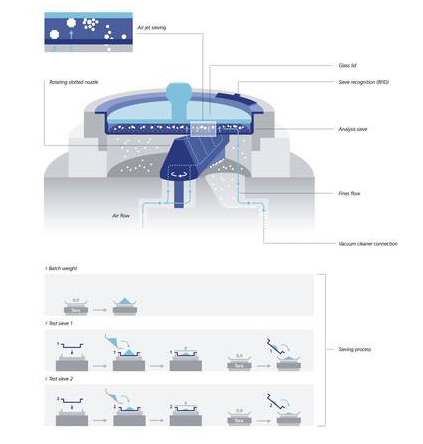Air-Jet Sieve
Home » Our Techniques » Air-Jet Sieve
Particle Size Distribution Analysis Using an Air-Jet Sieve
EAG Laboratories offers a full portfolio of particle size measurement techniques, covering a range of more than six orders of magnitude. Air-jet sieve analysis is an analytical technique to determine the particle size distribution of dry, powdery materials in the 45-5600 µm range. Typical applications include: raw materials for glass production, recycled glass and materials for 3D-printing.
First step is to place the sample on a sieve. This sieve is mounted in an airtight container. Air is blown upwards through the sieve from a rotating nozzle to fluidize the sample. The exit airflow carries undersized particles downward through the sieve. Starting with the finest sieve, the amount of material passing is determined by weighing. The retained sample is transferred to the next larger sieve size, and the procedure is repeated until sieving has been done on all required sieves in succession.
Schematic representation of the principle of the air-jet sieve analysis technique is pictured.

Ideal Uses of Air-Jet Sieve Analysis
- Weight fraction distribution analysis of dry powders
Strengths
- No sample preparation needed
Limitations
- The sample is lost
- Only suitable for dry powdery materials
- Limited number of mesh sizes available (45, 63, 90, 125, 180, 250, 355, 500, 710, 1000, 1400, 2000, 2800, 4000 and 5600 µm)
Air-Jet Sieve Technical Specifications
- Sample amount: approx. 10-100 g
- Sieve dimensions: 200 mm in diameter with mesh sizes between 45 and 5600 µm
- Under pressure underneath sieve: approx. 600-7000 Pa
- Air flow rate: approx. 45-70 m3/h
Would you like to learn more about using Air-Jet Sieve?
Contact us today for your Air-Jet Sieve needs. Please complete the form below to have an EAG expert contact you.